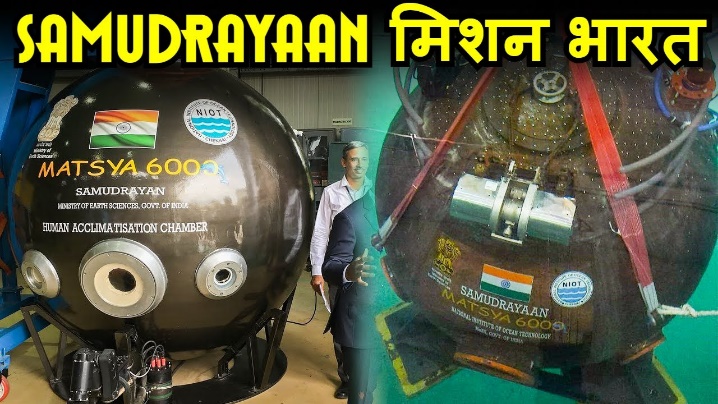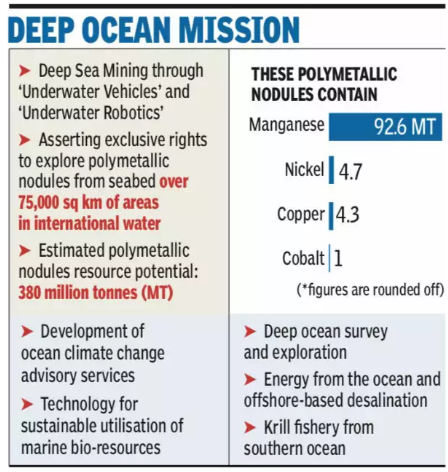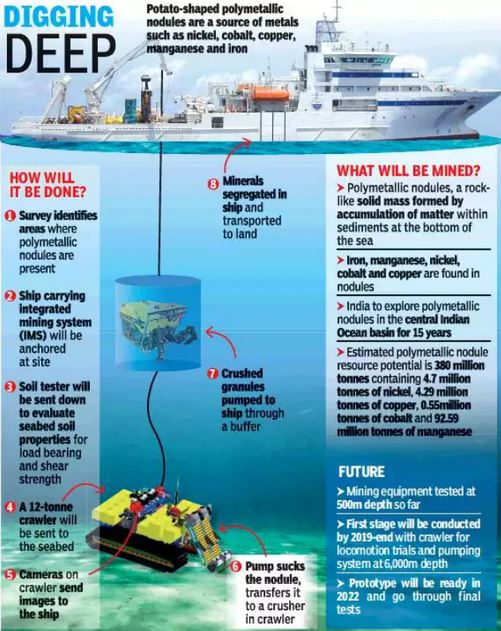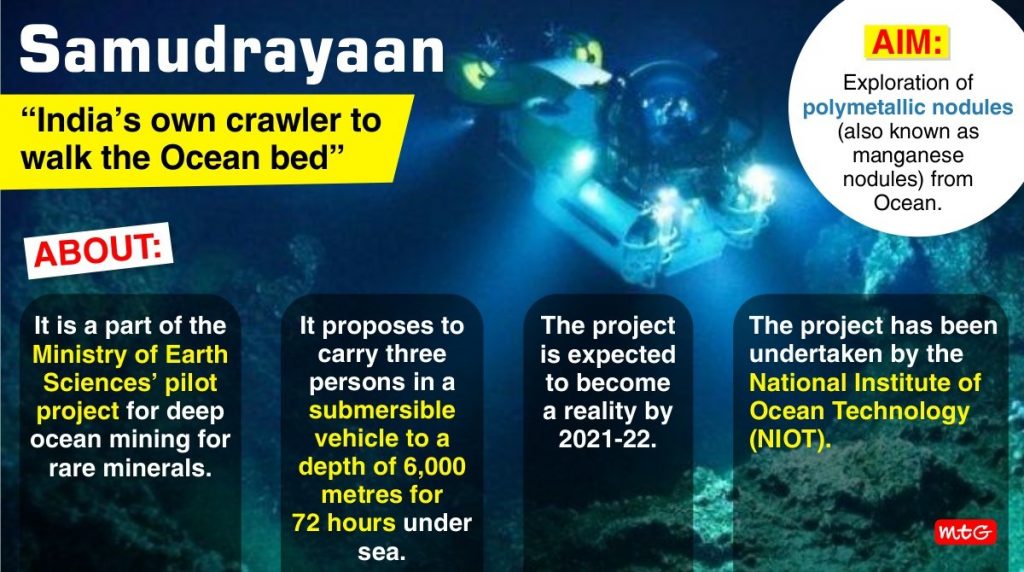
Disclaimer: Copyright infringement not intended.
Context
- The National Institute of Ocean Technology (NIOT), is in the process of developing a manned submersible vehicle called ‘Matsya 6000’.
- This would be in partnership with the Naval Science and Technological Laboratory (NSTL),
- The programme is called ‘Samudrayan’ on the lines of ‘Gaganyan’.
Details
- Matsya 6000, being developed under the Deep Ocean Mission, will be capable of taking three humans to a depth of 6 km. NSTL will provide hydrodynamic testing of the equipment.
- The manned submersible facilitates the direct observation by the human in the deep ocean in exploring mineral resources rich in Nickel, Cobalt, rare earth, manganese and other resources which can be used for scientific analysis.
- MATSAY-6000 vehicle, has an endurance of 12 hours in case of emergency for human safety.
Matsya 6000, being developed under the Deep Ocean Mission
Background
About Deep Ocean Mission
- Deep Ocean mission is an initiative to undertake the deep ocean exploration focused on India's exclusive economic zones and continental shelf.
- It is under Ministry of Earth Sciences (MoES).
Objective
- It aims to search for deep-sea resources and minerals, flora and fauna, including microbes, and studying ways to sustainably utilise them.
.jpg)
Components
There are six components to the programme.
(1) Development of Technologies for Deep Sea Mining, and Manned Submersibles:
- A manned submersible will be developed to carry three people to a depth of 6000 metres in the ocean with suite of scientific sensors and tools for mining Polymetallic Nodules.
(2) Development of Ocean Climate Change Advisory Services:
- It entails developing a suite of observations and models to understand and provide future projections of important climate variables on seasonal to decadal time scales.
(3) Technological innovations for exploration and conservation of deep-sea biodiversity
- Bio-prospecting of deep-sea flora and fauna including microbes and studies on sustainable utilization of deep-sea bio-resources will be the main focus.
- This component will support the Blue Economy priority area of Marine Fisheries and allied services.
(4) Deep Ocean Survey and Exploration
- To explore and identify potential sources of hydrothermal minerals that are sources of precious metals formed from the earth’s crust along the Indian Ocean mid-oceanic ridges.
(5) Energy and freshwater from the Ocean
- Involves studying and preparing detailed engineering design for offshore Ocean Thermal Energy Conversion (OTEC) powered desalination plants.
(6) Advanced Marine Station for Ocean Biology
- Aimed at development of human capacity and enterprise in ocean biology and engineering.
.jpg)
Importance
- India’s Exclusive Economic Zone spreads over 2.2 million square kilometers.
- India has been allotted a site of 75,000 square kilometres in the Central Indian Ocean Basin (CIOB) by the UN International Sea Bed Authority for exploitation of polymetallic nodules (PMN).
- These are rocks scattered on the seabed containing iron, manganese, nickel and cobalt.
- 380 million metric tonnes of polymetallic nodules are available at the bottom of the seas in the Central Indian Ocean.
- A fraction of that reserve can meet the energy requirement of India for the next 100 years.
Samudrayaan Project under the Deep Ocean Mission
- National Institute of Ocean Technology (NIOT), an autonomous Institute under the Ministry of Earth Sciences, had developed and tested a 'personnel sphere’ for a manned submersible system for 500 metre water depth rating.
- Personnel Sphere of 2.1m diameter to be used as a crew module up to 500 m water depth has been developed using mild steel and tested up to 600 m water depth in the Bay of Bengal using the research Vessel Sagar Nidhi.
- One Titanium alloy personnel sphere for manned submersible system for 6000-metre water depth rating, is under development.



Significance
- The mission is aimed at having a good impact on about 7517 km long coastline, spread over 9 coastal states and 1,382 islands. This will give a boost to the government's effort of making positive changes in the 'Blue Economy' as one of the ten core dimensions of growth.
- Mission 'Samundrayaan' has immediate spin-offs in the form of underwater engineering innovations in asset inspection, tourism and promotion of ocean literacy.
https://www.pib.gov.in/PressReleasePage.aspx?PRID=1782196







